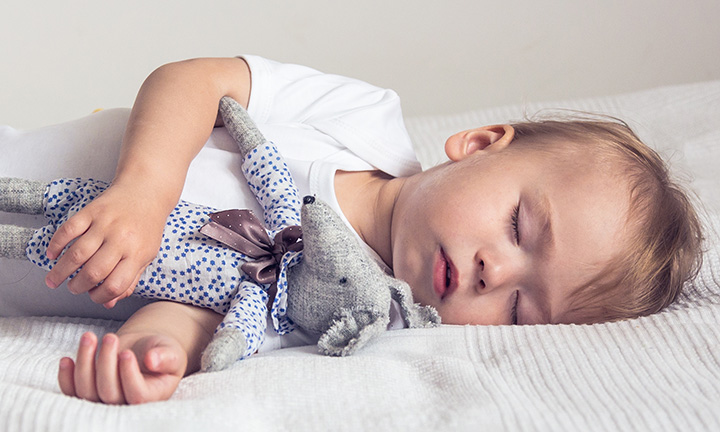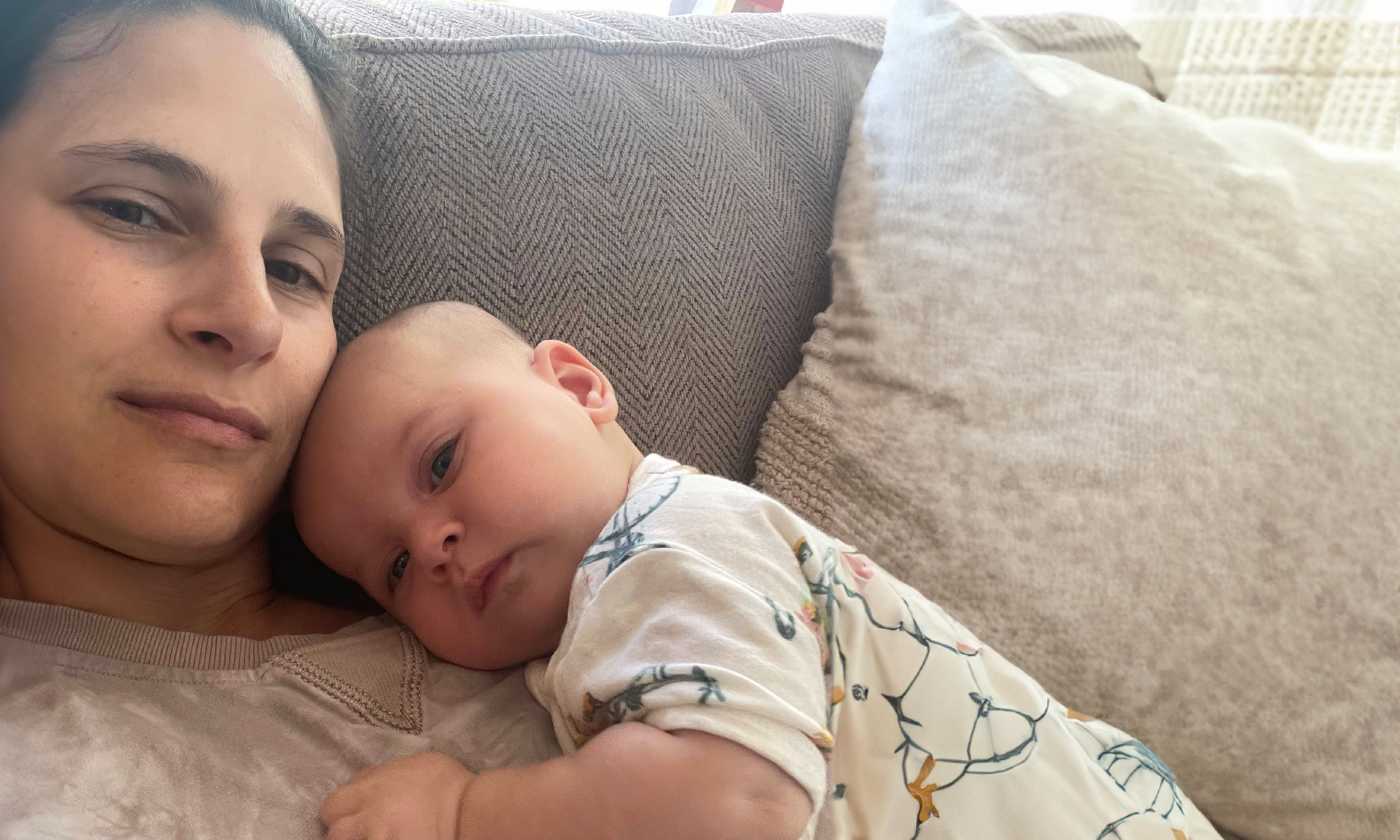
Baby Nap Schedule by Age: How Many Naps Babies Need
5 min readUpdated August 29, 2025

Chief Pediatric Sleep Consultant
5 min readUpdated August 29, 2025

Chief Pediatric Sleep Consultant
IN THIS ARTICLE
Creating a consistent baby nap schedule is one of the most effective ways to support healthy development and improve nighttime sleep. As your baby grows, their nap needs shift from multiple naps a day to eventually just one. Knowing when to expect these changes can help you avoid overtiredness, ease transitions, and keep your routine on track.
Quick tips for managing naps:
Whether you're navigating a 4-month-old sleep schedule, adjusting your 6-month-old nap schedule, or wondering when babies go down to one nap, understanding your baby’s evolving needs can make daily routines smoother for both of you. Let’s walk through how to build a flexible, healthy infant sleep schedule from birth through toddlerhood.
Why Naps Are Important for Your Child’s Development
Regular naps are more than just a way to help your baby rest—they’re an important part of their growth and daily rhythm. A consistent infant sleep schedule that includes daytime naps can support everything from mood to memory. Research suggests that well-rested babies and toddlers may have longer attention spans and sleep better at night than those who skip naps.
Here are a few reasons why naps matter for your child’s development:
And naps aren’t just helpful for your baby, they’re useful for you, too. While your child rests, you get a moment to relax, recharge, or take care of tasks that are harder to manage when your baby is awake.
Developing a Nap Schedule
Creating a nap schedule for your little one can help your child get better quality sleep at night. A baby nap schedule by age supports your child’s development by ensuring naps are appropriate for their stage and sleep needs, making it easier to follow a consistent sleep schedule.
Start by tracking your child’s sleep times and paying attention to signs of sleepiness, like fussiness, rubbing their eyes, or staring off. Over time, you’ll likely begin to notice natural windows when your little one is ready to rest. These clues can help you create a nap schedule that aligns with your child’s natural rhythm.
There will be days when naps don’t happen as planned, and that’s OK. Just aim to get your child back on track at the next opportunity.
If your baby is fighting naps or you’re looking for helpful tips to get sleep on track, take this FREE sleep assessment, brought to you by the Smart Sleep Coach app by Pampers. It can help you figure out how to solve common sleep challenges, allowing everyone to rest more peacefully.
The Best Times for Naps
Every child is unique, and tracking your little one’s sleep will help you pinpoint specific naptimes that work best for your kiddo. For many babies and toddlers, the best times for naps are mid-to-late morning and early afternoon. A nap typically lasts anywhere between 30 minutes and 2 hours. Your child may need to nap more often or less often, depending on their age and stage of development. Understanding baby naps by age can also help you adjust your baby’s sleep schedule accordingly.
Try to avoid naps after 3 or 4 p.m., as your little one may not be tired enough when bedtime arrives. Leaving at least four hours between their last nap and bedtime often works well.
If your child isn’t sleepy by bedtime, you could try adjusting the timing of their afternoon nap or shortening its length. If naps start to interfere with nighttime sleep, your child may be ready to drop that nap altogether.
On the other hand, missing a nap might make it harder for your child to fall asleep at night or lead to nighttime waking, because they’re overtired by bedtime. A consistent baby nap schedule that’s responsive to your child’s cues can help reduce those disruptions and support more restful nights.
Number of Naps Per Day by Baby Age
As your baby grows, their sleep needs and nap patterns will change. Most children gradually shift from multiple naps a day to just one, and eventually none. The table below provides a general idea of the number of naps your baby or toddler might take, based on their age. Keep in mind that this is just a guide; every child has their own unique rhythm.
Here’s a quick guide by age:
For many babies, the transition to two naps a day typically occurs between 8 and 12 months old, as their infant nap schedule begins to settle into a more consistent rhythm, often with one nap in the morning and another in the afternoon.
That said, it’s completely normal if your toddler isn’t quite ready to drop to one nap. For example, a 2-year-old's nap schedule may still include two shorter naps spaced throughout the day. Since every child’s needs are different, keep an eye on your little one’s cues and adjust the baby nap schedule based on what seems to work best.
0 to 3 Months Old
It takes time for newborns to settle into a regular sleep schedule. Some babies fall into a rhythm earlier than others, but in these first few months, sleep is mostly guided by your baby’s internal clock.
During the first month, babies sleep about 14 to 17 hours each day, often in stretches of 3 to 4 hours spaced evenly between feedings. Most newborns need to sleep again after being awake for just 1 to 2 hours.
There’s no need for a formal newborn nap schedule yet—your baby’s sleep will likely happen in short bursts around the clock. As their internal rhythm matures, they’ll gradually spend longer stretches asleep at night and shorter periods napping during the day.
This early stage is all about responding to your baby’s cues and letting them sleep when they need it, laying the foundation for a future infant sleep schedule and a consistent bedtime routine.
4 to 12 Months Old
Between 4 and 12 months, most babies establish a more regular sleep schedule, typically with two to three daytime naps and longer nighttime stretches of sleep.
You can try setting nap times around 9 a.m. and 1 p.m. and let your little one nap as long as they need, unless it starts to affect how easily they fall asleep at bedtime. Following your baby’s natural rhythm helps support a consistent sleep schedule for your baby.
Around 9 months old, some babies may still take a third nap in the late afternoon. If this begins to interfere with nighttime sleep, you can gradually phase it out. Throughout 10 to 12 months, many babies drop the morning nap and shift toward a more consolidated nap schedule, with one longer nap and one shorter nap during the day.
Infants in this age range typically sleep 12 to 16 hours in 24 hours, including both naps and nighttime sleep.
1 to 2 Years Old
By age 1, your baby has likely dropped the morning nap and transitioned to a single, longer nap in the afternoon. You can try shifting the afternoon nap and bedtime earlier by about 30 minutes to support a smoother 1-year-old sleep schedule.
Most toddlers in this age range sleep approximately 11 to 14 hours in 24 hours, including naps and nighttime sleep. While young toddlers may still take two naps a day, most begin to drop down to one by around 18 months old.
Every child is different, so continue to adjust the baby's nap schedule based on your toddler’s cues and sleep needs.
Does Your Toddler Need One or Two Naps?
Many parents ask, “When do babies go to one nap?” While there’s no single answer, most toddlers start dropping from two naps to one sometime after their first birthday. But during the transition, it’s normal for your toddler’s needs to vary from day to day.
There isn’t a fixed rule for how many naps a 1-year-old should take. Some toddlers still need two naps for a while, while others do fine with one. It often depends on how well they slept the night before and how their day is going.
Experts suggest adjusting based on your toddler’s cues:
Continue to observe your child’s energy levels and behavior throughout the day. Flexibility is key during this transition, and so is keeping a consistent baby nap schedule that works for your family.
When Do Kids Stop Napping?
After about 3 years of age, your toddler may start to give up naps entirely and switch to sleeping only at night. However, some children may stop napping as early as 2 years old, whereas others may still need to take a nap or two even at about 5 years old.
Tips for Creating a Naptime Routine
A naptime routine is like a shorter version of a bedtime routine. Babies and toddlers thrive on consistency, and having a predictable wind-down helps them settle more easily. You can start a simple routine as early as 6 to 8 weeks old.
Keep the routine calm and soothing. Try to end it in the space where your child will nap. Whether that’s your room or theirs, so they begin to connect sleep with that environment.
Here are some things your naptime routine can include:
What matters most is doing it the same way each time. If someone else is watching your child, share the routine so it stays consistent.
For toddlers, naps might start to feel like a battle. If your child resists, don’t force it. Instead, offer quiet time in their room. Even if they don’t fall asleep, the downtime can still help them recharge—and they might surprise you by dozing off anyway.
Creating an Ideal Environment for Naps
A calm, cozy environment can make it easier for your baby or toddler to fall—and stay—asleep during naps. Here are a few tips to help set the scene:
A consistent, safe nap space not only encourages better rest, but it can also help your child feel more secure and comfortable as they grow.
FAQS AT A GLANCE
Your baby should nap in a crib, bassinet, or portable play yard. Avoid letting them sleep on couches, car seats, or slings. If they fall asleep in one, move them to a safer sleep space as soon as possible.
The Bottom Line
Naps play a significant role in your child’s development. A consistent baby nap schedule by age can support mood, focus, and even better nighttime sleep. Early on, your baby may nap three to four times a day, but as they grow, the number of naps by age gradually decreases.
Creating a calm, safe space for naps helps your child rest well and gives you a much-needed break. Once your child settles into a predictable routine, it becomes easier to plan your day around those rest periods.
Want to save on diapers and wipes? Download the Pampers Rewards App to access exclusive digital offers.










